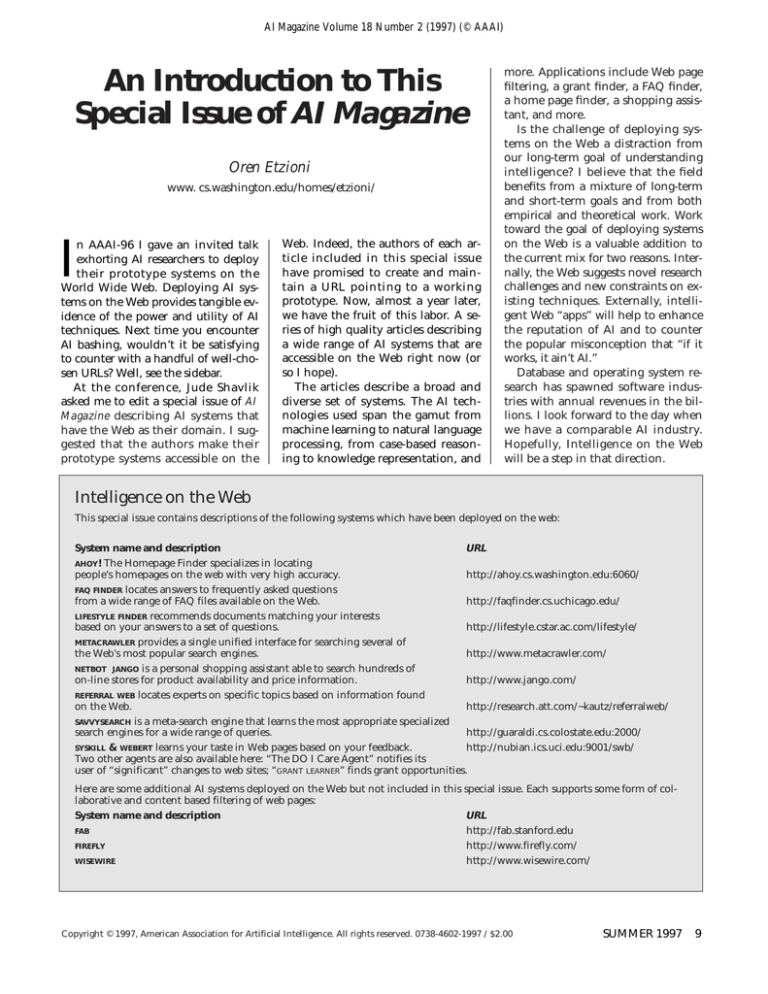
AI Magazine Volume 18 Number 2 (1997) (© AAAI)
An Introduction to This
Special Issue of AI Magazine
Oren Etzioni
www. cs.washington.edu/homes/etzioni/
I
n AAAI-96 I gave an invited talk
exhorting AI researchers to deploy
their prototype systems on the
World Wide Web. Deploying AI systems on the Web provides tangible evidence of the power and utility of AI
techniques. Next time you encounter
AI bashing, wouldn’t it be satisfying
to counter with a handful of well-chosen URLs? Well, see the sidebar.
At the conference, Jude Shavlik
asked me to edit a special issue of AI
Magazine describing AI systems that
have the Web as their domain. I suggested that the authors make their
prototype systems accessible on the
Web. Indeed, the authors of each article included in this special issue
have promised to create and maintain a URL pointing to a working
prototype. Now, almost a year later,
we have the fruit of this labor. A series of high quality articles describing
a wide range of AI systems that are
accessible on the Web right now (or
so I hope).
The articles describe a broad and
diverse set of systems. The AI technologies used span the gamut from
machine learning to natural language
processing, from case-based reasoning to knowledge representation, and
more. Applications include Web page
filtering, a grant finder, a FAQ finder,
a home page finder, a shopping assistant, and more.
Is the challenge of deploying systems on the Web a distraction from
our long-term goal of understanding
intelligence? I believe that the field
benefits from a mixture of long-term
and short-term goals and from both
empirical and theoretical work. Work
toward the goal of deploying systems
on the Web is a valuable addition to
the current mix for two reasons. Internally, the Web suggests novel research
challenges and new constraints on existing techniques. Externally, intelligent Web “apps” will help to enhance
the reputation of AI and to counter
the popular misconception that “if it
works, it ain’t AI.”
Database and operating system research has spawned software industries with annual revenues in the billions. I look forward to the day when
we have a comparable AI industry.
Hopefully, Intelligence on the Web
will be a step in that direction.
Intelligence on the Web
This special issue contains descriptions of the following systems which have been deployed on the web:
System name and description
URL
AHOY! The Homepage Finder specializes in locating
people’s homepages on the web with very high accuracy.
http://ahoy.cs.washington.edu:6060/
FAQ FINDER locates answers to frequently asked questions
from a wide range of FAQ files available on the Web.
http://faqfinder.cs.uchicago.edu/
LIFESTYLE FINDER recommends documents matching your interests
based on your answers to a set of questions.
http://lifestyle.cstar.ac.com/lifestyle/
METACRAWLER provides a single unified interface for searching several of
the Web’s most popular search engines.
http://www.metacrawler.com/
NETBOT JANGO is a personal shopping assistant able to search hundreds of
on-line stores for product availability and price information.
http://www.jango.com/
REFERRAL WEB locates experts on specific topics based on information found
on the Web.
http://research.att.com/~kautz/referralweb/
SAVVYSEARCH is a meta-search engine that learns the most appropriate specialized
search engines for a wide range of queries.
http://guaraldi.cs.colostate.edu:2000/
SYSKILL & WEBERT learns your taste in Web pages based on your feedback.
http://nubian.ics.uci.edu:9001/swb/
Two other agents are also available here: “The DO I Care Agent” notifies its
user of “significant” changes to web sites; “GRANT LEARNER” finds grant opportunities.
Here are some additional AI systems deployed on the Web but not included in this special issue. Each supports some form of collaborative and content based filtering of web pages:
System name and description
URL
FAB
http://fab.stanford.edu
FIREFLY
http://www.firefly.com/
WISEWIRE
http://www.wisewire.com/
Copyright © 1997, American Association for Artificial Intelligence. All rights reserved. 0738-4602-1997 / $2.00
SUMMER 1997
9
INTELLIGENT
MULTIMEDIA
INFORMATION RETRIEVAL
Mark T. Maybury, Editor
Foreword by Karen Spärck Jones
I
ntelligent multimedia information retrieval lies at the intersection of artificial intelligence, information
retrieval, human-computer interaction, and multimedia computing. Its systems enable users to create,
process, summarize, present, interact with, and organize information within and across different media
such as text, speech, graphics, imagery, and video. These systems go beyond traditional hypermedia and
hypertext environments to analyze and generate media, and support intelligent interaction with or via
multiple media.
The chapters in this volume span a broad range of topics. The book is organized into seven sections: Content-Based Retrieval of Imagery, Content-Based Retrieval of Graphics and Audio, Content-Based Retrieval
of Video, Speech and Language Processing for Video Retrieval, Architectures and Tools, Intelligent Hypermedia Retrieval, and Empirical Evaluations.
Published by the AAAI Press / The MIT Press
500 pp., $40.00 ISBN 0-262-63179-2 Prices higher outside the U.S. and subject to change without notice.
To order call 800-356-0343 (US and Canada) or (617) 625-8569.
Distributed by The MIT Press, 55 Hayward, Cambridge, MA 02142
10
AI MAGAZINE



